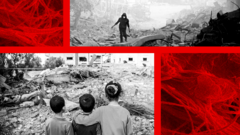Experts warn that the extensive destruction in Gaza has released toxic asbestos fibers into the air, threatening the health of millions, particularly vulnerable populations such as children.
**Asbestos Crisis in Gaza: A Hidden Health Catastrophe Amidst Ongoing Conflict**

**Asbestos Crisis in Gaza: A Hidden Health Catastrophe Amidst Ongoing Conflict**
Asbestos contamination in rubble poses significant long-term health risks for Gaza's population amidst the ongoing humanitarian crisis.
The conflict in Gaza has unmasked a silent yet deadly threat: asbestos. Once a common component in construction, this lethal mineral poses immense health risks when fibers are disturbed, as is the case following Israel's military operations. As reported by the United Nations Environment Programme (UNEP), an alarming estimate suggests that approximately 2.3 million tons of rubble throughout Gaza may harbor asbestos contamination. Asbestos materials, predominantly found in roofing across eight urban refugee camps, endanger surrounding populations, whose levels of awareness regarding the issue are worryingly low.
The ramifications of asbestos exposure are dire and insidious. When disturbed—such as during an airstrike—microscopic fibers become airborne and can be inhaled, leading to serious diseases, including asbestosis and mesothelioma, which is particularly aggressive and often diagnosed late due to indolent symptoms. Professor Bill Cookson from the National Centre for Mesothelioma Research emphasizes that even minimal exposure can trigger adverse health effects later in life. Alarmingly, illness onset typically spans 20 to 60 years post-exposure, pointing to a potential future crisis for Gaza's current residents.
Dr. Ryan Hoy's research highlights the pervasive nature of airborne asbestos, which can penetrate deep into lung tissues, endangering the densely populated region's inhabitants—many of whom are already grappling with immediate threats from ongoing military actions. Medical aid coordinator Chiara Lodi explained that, amidst pressing survival concerns, the population is preoccupied with more urgent dangers and lacks knowledge regarding the risks of asbestos.
Compounding the problem, prior investigations following the 2009 conflict identified asbestos fibers in debris of older infrastructure, suggesting longstanding issues exacerbated by current turmoil. Additionally, existing health risks associated with inhaling concrete dust, which often contains silica, may lead to chronic respiratory illnesses.
Globally, numerous countries have outlawed asbestos due to its carcinogenic properties, while Israel banned its use in 2011. Still, debris clearance from the recent conflict poses additional challenges, raising concerns regarding the potential disruption of asbestos-laden rubble during reconstruction efforts. With the UN projecting that the debris removal process may extend over two decades at a staggering estimated cost of $1.2 billion, the management of asbestos contamination remains a critical public health concern.
As the health crisis unfolds alongside the ongoing armed conflict, public health officials and international organizations must address the detrimental effects of debris-causing health issues that could result in even greater casualties than the violence itself, raising urgent calls for immediate action and awareness.
The ramifications of asbestos exposure are dire and insidious. When disturbed—such as during an airstrike—microscopic fibers become airborne and can be inhaled, leading to serious diseases, including asbestosis and mesothelioma, which is particularly aggressive and often diagnosed late due to indolent symptoms. Professor Bill Cookson from the National Centre for Mesothelioma Research emphasizes that even minimal exposure can trigger adverse health effects later in life. Alarmingly, illness onset typically spans 20 to 60 years post-exposure, pointing to a potential future crisis for Gaza's current residents.
Dr. Ryan Hoy's research highlights the pervasive nature of airborne asbestos, which can penetrate deep into lung tissues, endangering the densely populated region's inhabitants—many of whom are already grappling with immediate threats from ongoing military actions. Medical aid coordinator Chiara Lodi explained that, amidst pressing survival concerns, the population is preoccupied with more urgent dangers and lacks knowledge regarding the risks of asbestos.
Compounding the problem, prior investigations following the 2009 conflict identified asbestos fibers in debris of older infrastructure, suggesting longstanding issues exacerbated by current turmoil. Additionally, existing health risks associated with inhaling concrete dust, which often contains silica, may lead to chronic respiratory illnesses.
Globally, numerous countries have outlawed asbestos due to its carcinogenic properties, while Israel banned its use in 2011. Still, debris clearance from the recent conflict poses additional challenges, raising concerns regarding the potential disruption of asbestos-laden rubble during reconstruction efforts. With the UN projecting that the debris removal process may extend over two decades at a staggering estimated cost of $1.2 billion, the management of asbestos contamination remains a critical public health concern.
As the health crisis unfolds alongside the ongoing armed conflict, public health officials and international organizations must address the detrimental effects of debris-causing health issues that could result in even greater casualties than the violence itself, raising urgent calls for immediate action and awareness.




















